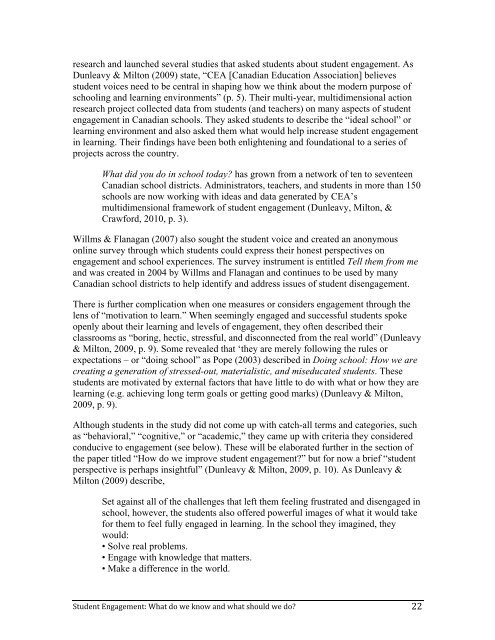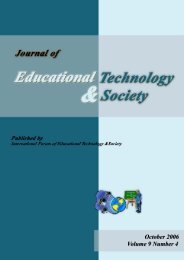Student Engagement: What do we know and what should we do?
Student Engagement: What do we know and what should we do?
Student Engagement: What do we know and what should we do?
Create successful ePaper yourself
Turn your PDF publications into a flip-book with our unique Google optimized e-Paper software.
esearch <strong>and</strong> launched several studies that asked students about student engagement. As<br />
Dunleavy & Milton (2009) state, “CEA [Canadian Education Association] believes<br />
student voices need to be central in shaping how <strong>we</strong> think about the modern purpose of<br />
schooling <strong>and</strong> learning environments” (p. 5). Their multi-year, multidimensional action<br />
research project collected data from students (<strong>and</strong> teachers) on many aspects of student<br />
engagement in Canadian schools. They asked students to describe the “ideal school” or<br />
learning environment <strong>and</strong> also asked them <strong>what</strong> would help increase student engagement<br />
in learning. Their findings have been both enlightening <strong>and</strong> foundational to a series of<br />
projects across the country.<br />
<strong>What</strong> did you <strong>do</strong> in school today? has grown from a network of ten to seventeen<br />
Canadian school districts. Administrators, teachers, <strong>and</strong> students in more than 150<br />
schools are now working with ideas <strong>and</strong> data generated by CEA’s<br />
multidimensional framework of student engagement (Dunleavy, Milton, &<br />
Crawford, 2010, p. 3).<br />
Willms & Flanagan (2007) also sought the student voice <strong>and</strong> created an anonymous<br />
online survey through which students could express their honest perspectives on<br />
engagement <strong>and</strong> school experiences. The survey instrument is entitled Tell them from me<br />
<strong>and</strong> was created in 2004 by Willms <strong>and</strong> Flanagan <strong>and</strong> continues to be used by many<br />
Canadian school districts to help identify <strong>and</strong> address issues of student disengagement.<br />
There is further complication when one measures or considers engagement through the<br />
lens of “motivation to learn.” When seemingly engaged <strong>and</strong> successful students spoke<br />
openly about their learning <strong>and</strong> levels of engagement, they often described their<br />
classrooms as “boring, hectic, stressful, <strong>and</strong> disconnected from the real world” (Dunleavy<br />
& Milton, 2009, p. 9). Some revealed that ‘they are merely following the rules or<br />
expectations – or “<strong>do</strong>ing school” as Pope (2003) described in Doing school: How <strong>we</strong> are<br />
creating a generation of stressed-out, materialistic, <strong>and</strong> miseducated students. These<br />
students are motivated by external factors that have little to <strong>do</strong> with <strong>what</strong> or how they are<br />
learning (e.g. achieving long term goals or getting good marks) (Dunleavy & Milton,<br />
2009, p. 9).<br />
Although students in the study did not come up with catch-all terms <strong>and</strong> categories, such<br />
as “behavioral,” “cognitive,” or “academic,” they came up with criteria they considered<br />
conducive to engagement (see below). These will be elaborated further in the section of<br />
the paper titled “How <strong>do</strong> <strong>we</strong> improve student engagement?” but for now a brief “student<br />
perspective is perhaps insightful” (Dunleavy & Milton, 2009, p. 10). As Dunleavy &<br />
Milton (2009) describe,<br />
Set against all of the challenges that left them feeling frustrated <strong>and</strong> disengaged in<br />
school, ho<strong>we</strong>ver, the students also offered po<strong>we</strong>rful images of <strong>what</strong> it would take<br />
for them to feel fully engaged in learning. In the school they imagined, they<br />
would:<br />
• Solve real problems.<br />
• Engage with <strong>know</strong>ledge that matters.<br />
• Make a difference in the world.<br />
<strong>Student</strong> <strong>Engagement</strong>: <strong>What</strong> <strong>do</strong> <strong>we</strong> <strong>know</strong> <strong>and</strong> <strong>what</strong> <strong>should</strong> <strong>we</strong> <strong>do</strong>? 22












